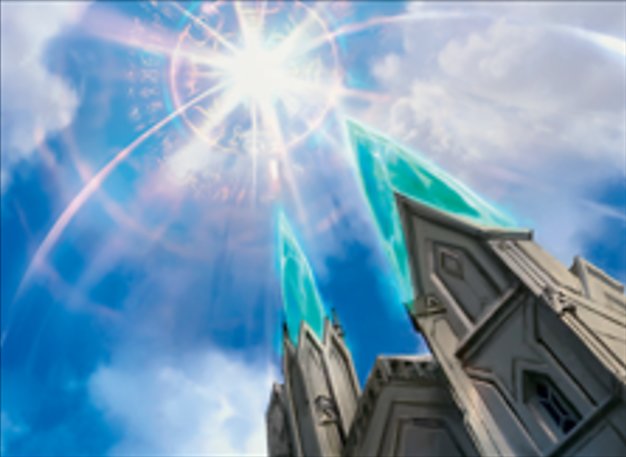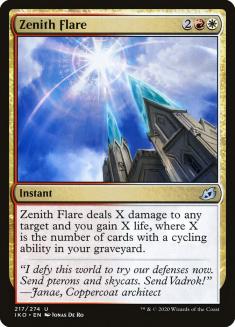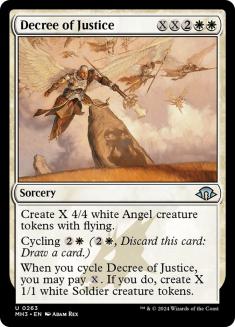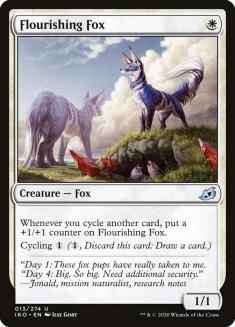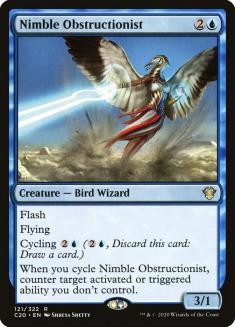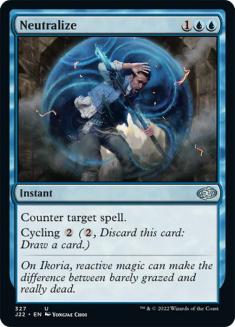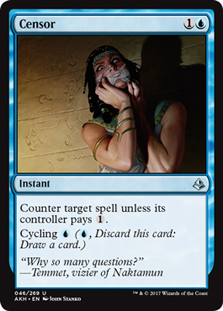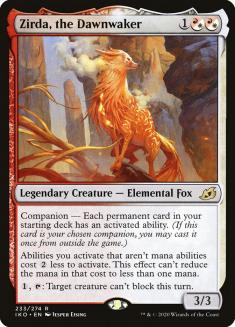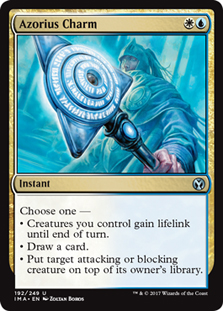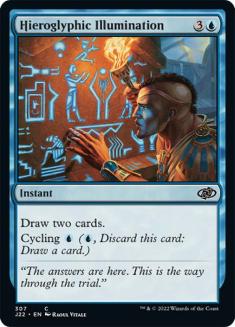While companions seem to be infiltrating just about every format, and making them arguably worse due to homogenization, I’d argue that Pioneer has actually gotten a bit better. No longer do you play against Lotus Breach or Dimir Inverter every round. Aggro decks are out in force, including multiple builds of Lurrus and Obosh, while midrange is shining with Yorion. I’ve scoured the internet for Pioneer decks in search of something fun, innovative, and powerful, and I believe I have found that deck.
One thing control decks usually lack is the ability to close the game. While you can play finishers like Teferi, Hero of Dominaria, those usually take a bit of time to actually win and have the problem of dying to removal spells while tapping you out on your own turn. Permanents in general are able to be killed or attacked or damaged. But what if you could play a control finisher that had a ton of utility in the early-game, but just ended it on the spot if you drew one or two in the later turns?
I didn’t think much of this card when I first saw it. It seemed like a cool card for Limited, but I figured cycling in general would force you to play too many weak cards for it to actually do anything. Turns out that all these cycling cards that only cost one mana from Ikoria: Lair of Behemoths are actually pretty solid, and many of the older ones from Amonkhet have some utility in a control shell!
The singular thing I search for when building a control deck is a finisher that has utility in the early turns of the game. If your finishing move costs seven mana plus your entire turn and doesn’t actually win the game, chances are your opponent will have a spot to capitalize either before or on the turn you cast said spell. That’s why I love engines like Wilderness Reclamation or Pyromancer’s Goggles, as those cards have significant utility before they actually win you the game.
Zenith Flare isn’t quite the same as those. It’s better.
One thing you notice about Zenith Flare upon playing with it for the first time is that it grows just by playing Magic. Many similar cards required some intense cycling of valuable resources in order to turn them on. Astral Slide and Lightning Rift were excellent payoff cards for cycling, but they didn’t reward you at all for playing Magic as normal. If all of your cards have cycling, Zenith Flare starts to feel more and more like “Deal X damage to any target and gain X life for each card in your graveyard.” And that, my friends, is a great card.
Much like Expansion // Explosion, Zenith Flare can be used in multiple ways throughout the game while still acting as a finisher. Spells like that are few and far between, and Zenith Flare is a truly amazing card that could very well generate its own archetype in a high-power format.
Creatures (6)
Lands (24)
Spells (30)

As I said, I found this deck perusing the Internet, and you can do the same. With everyone in lockdown, there are a lot of great minds playing all sorts of formats on Magic Arena (Arena) and Magic Online (MTGO). That means more innovation, more interesting builds, and the occasional format breaker. This might be the latter, if only because it acts almost exactly like a pure control deck with a one-card combo finish. That one-card finish is also tough to interact with and can be used as utility in the middle turns of the game.
There are a lot of elements of this archetype to talk about, so let’s get down to business.
Sharknado!
One of the coolest cards from Ikoria is Shark Typhoon. Modeled after a particularly odd yet culturally relevant movie series, Shark Typhoon is also modeled (loosely) after an older Magic card.
Decree of Justice was a phenomenal tool for control decks to generate blockers or eventually finish the game in one fell swoop. It couldn’t be countered by Mana Leak or anything else really because it was a triggered ability upon cycling as opposed to actually casting the spell. It changed control mirrors forever. Much like Decree of Justice, Shark Typhoon has those attributes, but it’s updated them a bit for the modern era.
Shark Typhoon is a monster. It’s a powerhouse. It’s just phenomenal. At every point in the game, it’s viable. Cycling it on two to hit your next land drop is more than fine. Making a 2/2 to ambush a Thraben Inspector or pressure an opposing planeswalker is serviceable. Making a giant Shark in the super-late-game and drawing a card while your opponent has Teferi, Time Raveler on the battlefield is absolutely sick.
It’s rare that I find a card to be much stronger than initial impressions upon first casting it myself. Most Magic players can read a card and mostly understand it, but Shark Typhoon is not a card you truly understand until you cycle it for the first time. Casting it is almost an afterthought. In fact, I would wager that you will win far more games on average if you never cast Shark Typhoon. Much like Decree of Justice was rarely, if ever, used to make Angels, Shark Typhoon should almost always make a gigantic flying Shark while drawing a card. Putting it onto the battlefield taps you out and makes you vulnerable to Disenchant effects or the like. Plus you spend all that mana and don’t get a Shark or anything for your trouble!
This is one I’m not so sure about yet, but after talking with Peter about it he confirmed some of my beliefs. Flourishing Fox is a card you rarely cast unless you’re playing against combo or control. Most of the time, it functions as your Opt or Serum Visions, cycling so you hit land drops or draw into more valuable spells. Flourishing Fox is quite strong against a combo opponent, as it turns your early cyclers into raw damage output. It gets big in a hurry!
By far the most valuable part of Flourishing Fox is that it cycles for one mana. While you can play all sorts of cards that cycle for one mana, you want some of those to be good in specific situations. Lotus Breach is one of the premier decks in Pioneer, so having your control deck contain a potential beatdown element for almost no investment is huge. Control decks tend to have good combo matchups if you have the right tools, and occasionally that “right tool” is a beatdown element. Because of how cycling works, getting to maindeck that tool is useful and saves valuable sideboard space.
I found this one to be a bit of a bummer, but it has some nice utility. On occasion you get to snipe something that is usually impossible to snipe, including but not limited to Fabled Passage. Like Stifle or Trickbind before it, cards like Nimble Obstructionist are rarely realized for their potential at first glance. Think about it! In a lot of cases, it acts like a Vendilion Clique, but on occasion it just keeps you from losing to a planeswalker ultimate!
One thing you can do with Nimble Obstructionist is protect your other threats from enchantments that exile your stuff. It can stop Elspeth Conquers Death or Baffling End while drawing a card. It can give you an out in spots you didn’t realize you needed or had to begin with. Nimble Obstructionist is versatile, and that’s exactly what you need from a card that cycles in a cycling deck.
Still, I found it getting stuck in my hand quite often, holding it far longer than I should have. It’s possible I should have cast it at some point just for a 3/1 flyer instead but it’s such a strange card that’s really tough to evaluate sometimes. It’s on the chopping block for now, but I could see myself bringing it back in big numbers depending on how the metagame shifts. If you wanted, you could build this a lot like Jeskai Flash, utilizing the trickiness of all your cards to gain significant advantages in the right spots. The fact that everything cycles can be an afterthought.
Neutralize is just a Cancel that cycles, but all sorts of cards that act like Cancel are playable in Pioneer. Sinister Sabotage, for example, has been one of my favorite counterspells in the format since its inception. Neutralize is similar except it can cycle when you’re behind on the battlefield. Counterspells are often mediocre once you fall behind, but at least Neutralize can find something to do when your opponent has already established a battlefield.
It’s hard to say much else about the card. It counters spells and it can cycle. The fact that it has cycling is actually pretty important, because it helps grow Zenith Flare. Just by casting it as itself, you gain an effect that your deck is building toward. Growing Zenith Flare by one doesn’t mean much, but what if every spell has cycling and does the same thing? All those start to add up, and especially so when you cycle a card or two in the meantime.
Neutralize is also a fine pairing with Censor, as it gives you two types of protection that can both cycle once they’ve lost their usefulness. Censor has been great in Pioneer for a long time now, so it’s nice to have big brother come along for a one-two punch.
It’s rare that a companion is an afterthought, but in this build Zirda, the Dawnwaker isn’t a primary focus. Sure, it can be useful for making some cards cost two less to cycle, but this is just a “free eighth card” type of deal. Zirda isn’t making infinite mana or doing some sort of infinite combo, but there are some cool interactions that I didn’t notice until they came up in tight spots.
- Having Irrigated Farmland or Raugrin Triome cost less to cycle is big.
- Making Shark Typhoon two bigger for free is nothing to sneeze at.
- Making Castle Vantress cost less to activate is ridiculous.
- Protecting Zirda from Baffling End via Nimble Obstructionist for one mana is powerful.
Overall, I think Zirda is just fine. Nothing too powerful but certainly a fair card in its own right. It has some utility in the archetype and doesn’t require you to make too many deckbuilding sacrifices to make it playable. I’m just sad that I can’t play it alongside Search for Azcanta! Activating the backside of that thing for one mana would be a dream!
Not the biggest fan of this card in the archetype as it doesn’t physically say “cycling” on it. However, it is one of the most efficient removal spells that a deck like this can play, and it can “cycle” in a pinch if you need to find something more specific. I love Azorius Charm more than most people, because I’ve played with and against it a metric ton. I understand how frustrating it can be as an aggro player to have your creature put back on top of your library. Cheap creatures can lose utility as the game progresses, effectively turning the top of your deck into an almost dead draw while dealing with one of those problems on the battlefield.
As a control player, it can be hard to grok that side of things, as putting a creature on top of your opponent’s deck doesn’t actually deal with it permanently. It’s also hard to see the times where putting a creature on top of their deck is better than killing it, which is often.
One of my biggest questions about the deck was whether or not we should play four copies of Supreme Verdict. It’s a bit worse here than in traditional Azorius Control, as it kills our Sharks and Foxes. There is no denying that Supreme Verdict is powerful against aggro, but it’s more of a question of how good is it when the format is full of Lotus Breach and you have creatures in your deck that will die to your own card.
I think moving forward I’d recommend four copies in the maindeck. At the very least, it gives you a big reset button in tight spots. Most people are also playing creature-based decks, as that is what companions are doing to the format in general. Most of them have requirements that encourage you to play more creatures, which is why you’re seeing a push toward fair strategies and less combo across formats.
I love this card more than anyone should. I adore card draw that has alternate functionality, and the fact that this one acts like Opt or Inspiration is a big deal. I like that it can cycle early when you need land drops or give you a burst of resources if your opponent is hitting you with discard spells or just giving you time.
Among all things, versatility is most important in a deck like this. Cycling decks need their spells to do something useful when you actually have the mana for them. I’m pretty surprised it took us so long to get more stuff like Shark Typhoon! While that type of effect can be dangerous as it’s really tough to interact with, I’m all for versatility over raw power. I love piecing together a win via multiple angles, with all of your cards pushing toward one goal. This Jeskai Cycling deck feels like it’s doing exactly that.
If It Ain’t Broke…
The sideboard is currently built with an emphasis on Yorion Azorius Devotion, which has been fairly popular as of late. Glare of Heresy, for example, isn’t something you normally see a lot of in Pioneer. But it does exile Heliod! There aren’t a lot of Dimir Inverter players, which means we need fewer copies of Mystical Dispute and Narset, Parter of Veils. Those two cards are messed up in that matchup.
Blessed Alliance is fine and might be the best card for the slot. You can play Seal Away or other permanents like it but it will turn off Zirda, so you want that permanent to be something like Damping Sphere or Rest in Peace in order to lose your companion. I doubt there’s anything in Pioneer other than Lotus Breach (and Damping Sphere) that would make me want to lose Zirda.
The next time I play this deck, I’ll be trying out the following list. Not much has changed, but that’s mostly because the original deck (and builder) are great. I just think it’s important to experiment and try out new stuff. Here I want to test four copies of Supreme Verdict maindeck and Damping Sphere out of the sideboard for Lotus Breach. The deck has been popping off lately, so a little added help seems solid, even if you lose Zirda as a companion after sideboard.
Creatures (4)
Lands (24)
Spells (32)


